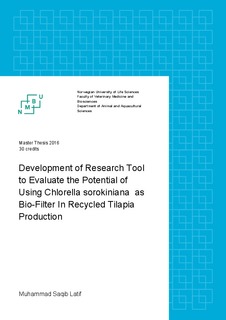| dc.description.abstract | The current study was attempted to develop the research tools in order to evaluate if
Chlorella sorokiniana has a potential to perform as a bio-filter in recycle water tilapia
production. The overall objective was to test the hypothesis that C. sorokiniana will effectively
remove nitrogenous catabolites from the water and benefit the tilapia with oxygen and nutrients
by photosynthesis. Removal of ammonia and nitrite from the water is improved by fertilization
with phosphate, the 1st limiting factor for primary production in freshwater. A total of 9 tanks
were used for the experiment, and were divided into three treatment groups CON, HPG and
FPG. One group was kept as control group (CON), while other two groups were fertilized with
phosphate, either a full (FPG) or half (HPG) phosphate concentration. Phosphate fertilization
levels were determined by considering the adjusting the N:P ratio to 16:1, which is considered
optimal for growth of green algae found in the water (FPG), providing half of this phosphate
dose (HPG), and only giving the algae access to the phosphate excreted by the fish (CON).
Ammonium and nitrite values from each tank were calculated based on their molecular weight.
This obtained value was then calculated based on the molecular weight of Na2HPO4 and the
water volume in the tanks. The resulted value (3.73 mg/l) was a full phosphate concentration
i.e. 16:1 ratio, and was simply divided by two to get the half phosphate concentration (1.86
mg/l). The nitrogen excretion level used for the calculation was estimated by monitoring
excretion of NH4
+ into the water by Nile tilapia fed a fully plant based diet in a system that was
not inoculated with algae.
A wooden table and board (placed on ground) was used for placing tanks and plastic tubes
respectively. Each tank was filled with 12 L of water and was equipped with a heater, air stone
and a pump. In addition, each pump was connected with two ends of plastic tube (L = 10m, D
= 1cm) to make a closed system. Tubes were placed on a wooden board in such a way that
approximately 8.5 meters of each tube was exposed to the light. Dissolved oxygen, temperature
and pH were monitored regularly. Light was provided to the algae for photosynthesis purpose.
The whole experiment lasted for 9 days.
From day 1 to 4, a general pattern of ammonium, nitrite and phosphate concentrations in
the water after introduction of feed was followed. On day 5 and 6 same concentrations were
followed, after inoculating the system with algae and fertilization with different levels of
phosphate. In these two days no feed was offered to the fish. On day 7 and 8, as the system was
re-inoculated with algae and fertilized with phosphate at the three defined levels, and the
iv
concentrations of ammonium, nitrite and phosphate were monitored. A control measurement
was repeated on day 9 without feeding and phosphate fertilization.
Ammonium, nitrite and phosphate concentrations (n = 9) before and after algae inoculation
were 1.35, 0.02, 0.09 mg/l and 0.13, 0.01, 0.1 mg/l respectively. Similarly, concentrations
before and after fertilization in CON (0.26, 0.04, 0.02 mg/l and 1.13, 0.13, 0.09 mg/l), HPG
(0.15, 0.05, 0.04 mg/l and 0.42, 0.06, 0.11 mg/l) and FPG (0.11, 0.03, 0.07 mg/l and 0.34, 0.03,
0.08 mg/l).
A strong linear decrease in ammonium and nitrite concentration with the increase of
phosphate dose was found i.e. FPG performed the best followed by HPG and CON. The
decrease was stronger for ammonium than nitrite, which suggest ammonium as the preferred
nitrogen source for assimilation in Chlorella.
Based on the data, it is proposed that Chlorella sorokiniana has a potential to be used as a
bio-filter in recycled tilapia production. Further studies needed to be undertaken for appropriate
understanding of the system before practical application. | nb_NO |

